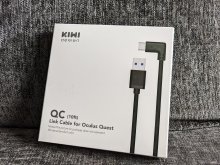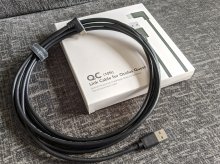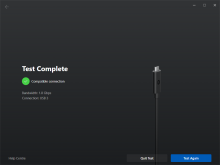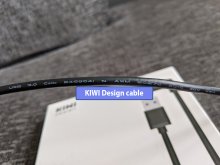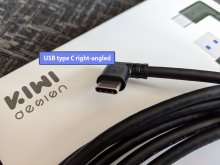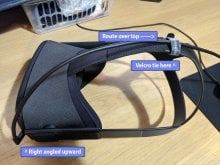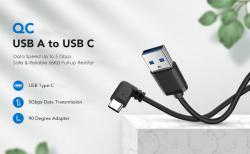 KIWI Design 10ft (3m) Oculus Quest Link cable (Hardware)
KIWI Design 10ft (3m) Oculus Quest Link cable (Hardware)
Official GBAtemp Review
Product Information:
- Official Store: https://www.kiwidesign.shop
Review Approach:
When initially released, the Oculus Quest was a standalone VR headset and was limited to the Oculus store ecosystem. However, thanks to Oculus Link you can now connect the Quest to a PC and take advantage of the expansive PCVR library which opens up a world of new experiences and functionality (providing you have a compatible GPU*).
When Oculus Link was first released back in September 2019, it was very particular about the USB cables it would be compatible with.
To get Link working properly it required you to have a high quality USB 3.0 compatible cable and even then only specific cables and USB ports seemed to work. Thankfully that is no longer the case and as Link has aged, compatibility has grown along with it.
While some users may opt for unofficial wireless solutions to get their Oculus Quest working on their PC such as ‘Virtual Desktop’ by Guy Godin, I have found that it introduces enough lag to make certain games uncomfortable to play. It also has quite strict requirements to get it working to its maximum potential such as high quality 5ghz WiFi network. Whereas Oculus Link with a high quality USB 3.0 cable provides a much more responsive and stable connection.
Oculus have even made the official charging cable that comes with the Quest compatible with Link even though the cable is only USB 2 which means that visual quality through the Link may be degraded compared to a proper USB 3 capable cable. Link works by balancing the image quality and latency depending on the quality of your connection.
The KIWI Design 10ft (3m) Oculus Quest Link cable is a USB 3.0 certified cable which means you should get maximum visual clarity and the lowest latency possible using a compatible USB 3.0 port.
It's a cable!
Now, this is just a USB cable. I'm sure you've seen plenty of them!
The KIWI Design USB 3.0 Oculus Link cable has a USB 3.0 type A connector on one end and a right-angled type C connector on the other.
The cable is approximately 10ft or 3m in length which is fine for use when sitting at a PC but for room scale VR it’s going to be a bit short. Unfortunately standard USB 3.0 cables are limited to 10ft/3m in length so an active USB 3.0 extension cable will be required to extend the cables use for room scale VR.
A velcro strap is included on the cable which alongside the right-angled connector, make for a neat connection on the Quest as it allows you to route the cable alongside the headset strap and keep it held in place with the velcro strap. This is the most comfortable way to wear it in my testing, rather than just letting the cable drop down in place which results in uncomfortable pulling due to the extra weight added to the side of the headset.
Let’s compare the KIWI Design cable to the fan-favourite Anker Powerline cable which is a tried and tested cable available on Amazon, which I have also previously used for Oculus Link.
Weight:
Compared to the Anker cable, the KIWI Design cable is immediately lighter and more flexible. The Anker cable feels a lot more rigid and its extra weight makes for a more cumbersome experience when connected in VR. The lighter and more flexible KIWI Design cable is noticeably nicer to use.
Anker USB C Cable, Powerline USB 3.0 to USB C Charger Cable: 155 grams
KIWI design 10ft (3m) Oculus Quest Link cable: 88 grams
Speed test:
Using the Oculus Link PC software we can run a test to find out the effective link speed of the cable. Let’s run the test and compare the Anker and KIWI cables.
Anker cable (direct USB connection) 1.8 gbps
KIWI cable (direct USB connection) 1.8 gbps
Anker cable (via active USB extension) 1.6 gbps
Kiwi active (via active USB extension) 1.6 gbps
The KIWI Design cable can charge the Quest, but during play the battery will drain faster than the USB 3.0 can keep up with. Although it will last a little longer than playing from the battery alone, a USB 3.0 port can simply not provide the current needed to charge and play simultaneously.
Final Thoughts
All in all, the KIWI Design 10ft (3m) link cable works just great. It’s a high quality USB 3.0 cable that works perfectly with the Oculus Link. It’s high quality and lightweight construction make it a perfect choice and personally I prefer it over the chunky Anker Powerline cable that so many recommend.
As an alternative to the $80 official Link cable at a quarter of the price you won’t go wrong.
Verdict
- Lightweight and flexible
- Right-angled connector
- Easy to use velcro strap
- Only 16ft / 3m in length
